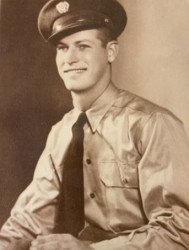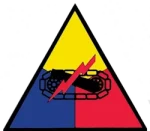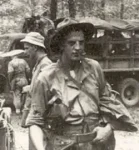S/Sgt. James Timothy Lee was born in Berkeley, Illinois, on August 29, 1920, to Gregory I. Lee and Mary T. Flavin-Lee, and had a sister and brother. His family resided at 5721 Bohlander Avenue, Berkeley. When he was one year old his mother died. His father married Mary Ryan and James had two half-brothers from the marriage. He graduated from Sunnyside School and attended Proviso Township High School for three years. After leaving school, he worked for T. J. Peters Company as an apprentice painter.
When the Selective Service Act took effect on October 16, 1940, James registered for the draft and named his father as his contact person. He also indicated that he was living at 716 Monroe Avenue, River Forest, Illinois. Knowing he was going to be drafted into the US Army he enlisted in the US Army Air Corps on December 23, 1941, and was issued the serial number 16 036 606. It is known he did his basic training at Jefferson Barracks, St. Louis, Missouri. It is known that he trained as a radio operator.
At some point, he was assigned to the 522nd Fighter-Bomber Squadron which was activated on August 23, 1943. The squadron was part of the 27th Bombardment Group. Before James joined the 27th, it had fought in the Philippines in December 1941 and then was moved to Australia. It was then returned to the United States and stationed at Hunter Field, Georgia, in May 1942. It appears that it was during this time that James became a member of the unit. Other places the 27th was stationed at where Key Field, Mississippi, July 14, 1942; Hattiesburg, Mississippi, August 15, 1942; and Harding Field, Louisiana, October 21st to November 1942.
The 27th left the United States and it is known it was stationed in Ste-Barbe-du-Tlelat, Algeria, December 26, 1942; Nouvion, Algeria, January 5, 1943; Ras el Ma, French Morocco, April 4, 1943; Korba, Tunisia, June 8, 1943; Gela, Sicily, July 18, 1943; Barcelona, Sicily, September 3, 1943; Capaccio, Italy, September 18, 1943; Paestum, Italy, November 4, 1943; Pomigliano, Italy, January 19, 1944; Castel Volturno, Italy, April 10, 1944; Santa Maria, Italy, May 9, 1944; Le Banca, Italy, June 7, 1944; Ciampino, Italy, June 12, 1944; Voltone, Italy, July 4, 1944; Serragia, Corsica, July 10, 1944; Le Luc, France, August 25, 1944; Salon, France, August 30, 1944. During this time, he flew over 100 missions against the Axis Powers.
What is know is that his unit was transferred to Loyettes, France, September 11, 1944. James and other 12 other members of the 27th, and two civilians, boarded their bomber, a B-25 Mitchell Bomber, to make the move to their new base of operations. According to available information, there was a heavy fog when the plane was taking off and the plane crash into the side of the mountain Annoisin-Chatelans killing all on board. James had suffered multiple fractures. The next day, the bodies of the crew were buried in the Civilian Cemetery, Cremieux, France. When James was buried, his two government issued identification tags were buried with him as well as a sealed identification bottle in Grave 7.
On December 20, 1944, the military already had begun of consolidating burials into a central cemetery and James’ remains were exhumed and moved to the US Military Cemetery Luynes, France. On December 25, 1944, in a shroud, James was buried in Plot B, Row 22, Grave 260. His grave was marked with a wooden cross with his name, rank and serial number on it. His father was sent a letter dated August 15, 1946, telling him where James was buried and the location of his grave in the cemetery. He was also told that in another letter he would be provided with information on his options for his son’s final burial. In October 1946, Fifty-sixth Avenue, in Berkley, was renamed Lee Avenue in honor of S/Sgt. James T. Lee.
Another letter, dated September 29, 1947, was sent to his father providing him with information on where James could be buried He was asked to fill-out an enclosed form indicating where he wanted James buried and return it to the Office of the Quartermaster General, Washington DC. The office indicated that as of April 1, 1948, the form had not been received. When a Red Cross worker spoke with Gregg Lee, James’ father indicated that at first he was going to bury James in an American Military Cemetery overseas, but he had changed his mind which was why the form had not been returned. On June 2, 1948, a completed form was returned to the OQMG indicating that James should be returned to Illinois and buried at Camp Butler National Cemetery in Springfield.
James’ remains were exhumed again, on February 18, 1948, from the US Military Cemetery, Luynes, France, and taken by truck to the USMC Cemetery, Draguigan, France. It appears he was buried again. From there, on September 9, 1948, his remains were taken by train to the Casketing Point A, Cherbourg, France, an remained there until November 16th, when his casket was moved to the Port of Cherbourg. On November 27th, his casket was put on the USAT James A. Robison which sailed the same day. The ship arrived at the New York Port of Entry on December 6th, and the next day, the 7th, his casket was sent by train, with a military escort, to the Quartermaster Corps Distribution Center #8, Chicago, and arrived on the 9th.
On Train #1 of the Gulf, Mobile & Ohio Railroad, James’ casket was taken to Camp Butler National Cemetery, Springfield, Illinois, and arrived at approximately 2:50 am at the station on January 30, 1949. On January 31, 1949, Staff Sergeant James T. Lee was buried at Camp Butler National Cemetery, Springfield, Illinois, in Section C, Site 528.
The top photo is his grave at Camp Butler while the bottom photo shows his name on the memorial in Leyrieu, France.









